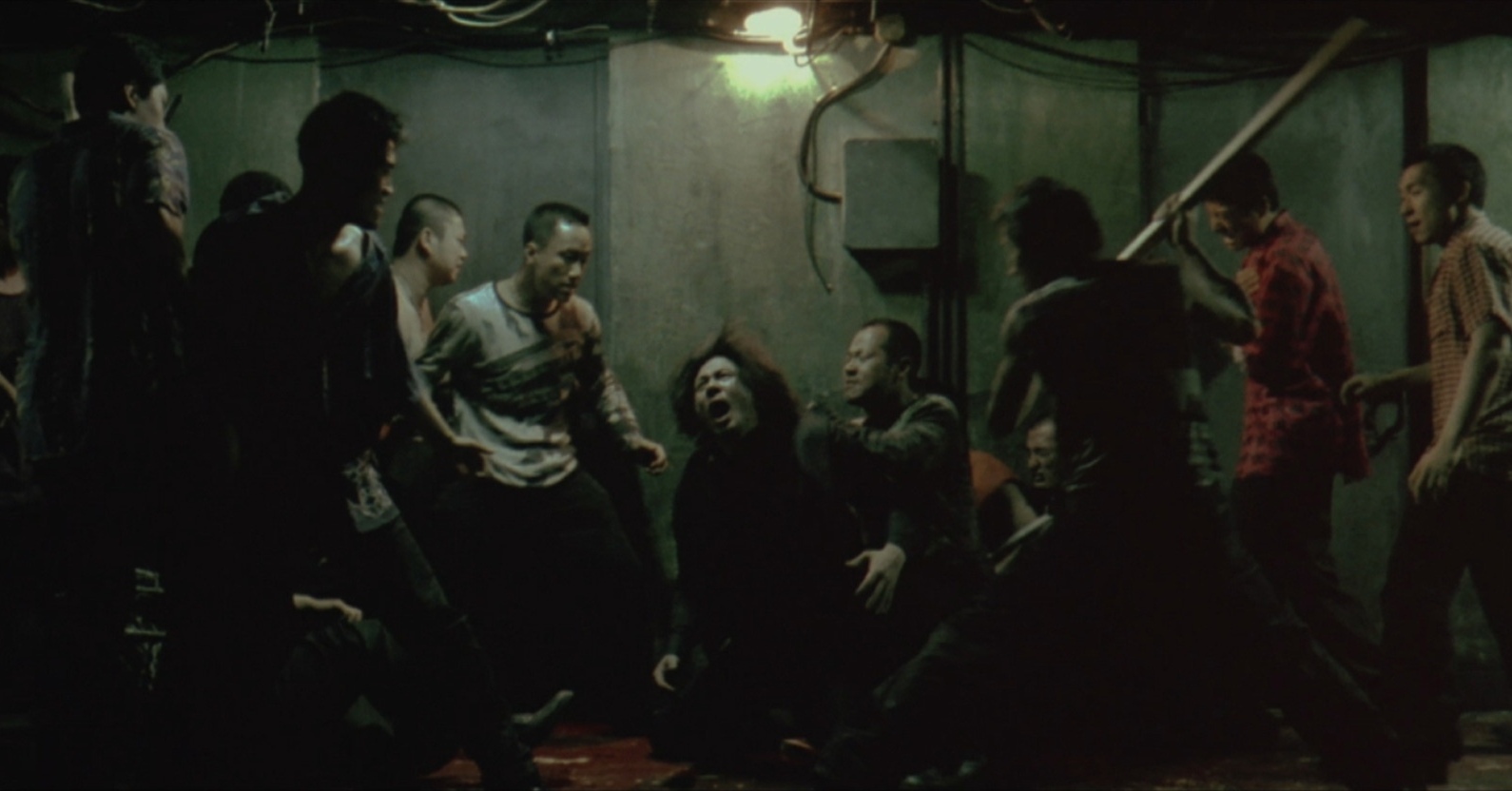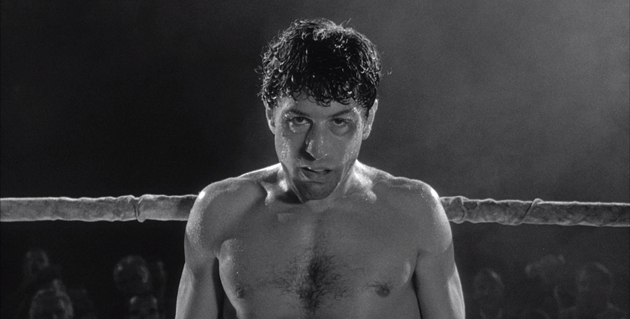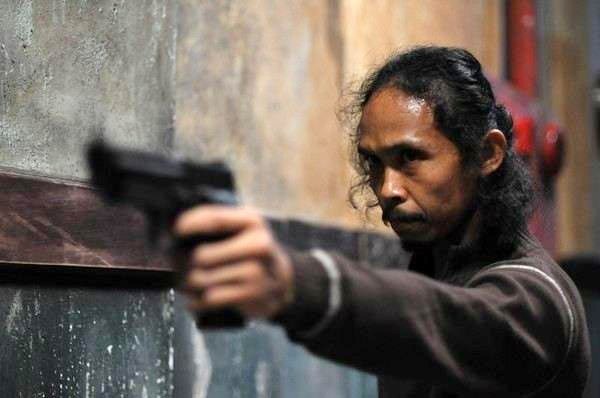17. They Live (1988) – Nada vs. Frank

In the original script, the key fight between Nada and Frank was only meant to take last 20 seconds. However, both Roddy Piper and Keith David spent several weeks choreographing an old school slugfest, reminiscent of the fights of John Wayne, which is now considered a classic.
Extended to over five minutes, the fight follows Nada’s attempts to convince Frank to try on the mysterious sunglasses, allowing him to see the aliens living amongst humanity. What follows is one of the most hilarious fights ever committed to screen. Both men are well-versed pugilists and their blows send each other flying across the alley.
There are even moments where it seems the characters are breaking the fourth wall, relishing in the fun they are having. After accidently breaking a car window, prompting an angry Frank to smash a beer bottle, both men start smirking, almost on the verge of laughing. This fight is a sheer joy to watch, simply because the joy of the actors in performing it.
16. Dragons Forever (1988) – Jackie vs. Henchman

Jackie Chan burst onto the screen as a breath of fresh air, choreographing and performing incredible feats of acrobatic art. Chan’s style has been compared to the likes of Buster Keaton, less of a fight scene and more of a comedic series of stunts. However, Chan, skilled in Kung Fu and Hapkido, as occasionally shown off his traditional fight skills, none so more than in Dragons Forever.
Alongside his fellow Three Brothers, Yuen Biao and Sammo Hung, the trio must battle a corrupt business owner and drug baron (Yuen Wah) culminating in a final battle in a factory. After defeating a number of nameless henchman, Chan’s Jackie confronts yet another nameless henchman, only this one happens to be former kickboxing champion Benny ‘The Jet’ Urquidez.
Chan and Urquidez faced off twice on screen, both times delivering iconic and eclectic fights, pushing Chan to his limits. Even to this day, Dragons Forever is one of his classics.
15. The Way of the Dragon (1972) – Tang vs. Colt

Two iconic fighters meeting in an iconic location. Sometimes it can be that simple. Hong Kong legend Bruce Lee had a number of prominent opponents throughout his career, including NBA legend and Jeet Kune Do student Kareem Abdul-Jabbar in Game of Death, but nothing was more iconic for Lee than his fight with Karate champion and future action star Chuck Norris.
Meeting in the Colosseum, the pair face off in a battle to death. What is on display is not just their fighting styles, but what they represent. East vs. West. Karate vs. Kung Fu. Street fighter vs. competition fighter. Lee and Norris could not be any more different yet even a fictional fight scene between the two shows the respect these opposing forces have for one another.
Lee not only starred in the film but also worked behind the camera, making his directional and screenwriting debut with the film. Sadly, Lee would pass away only a year after the film’s release but he left a remarkable legacy in both the world of film and martial arts.
14. Flashpoint (2007) – Ma vs. Tony

In the early 2000’s, Hong Kong star Donnie Yen travelled to the United States to launch a career in Hollywood similar to contemporaries Jackie Chan and Jet Li. However, unhappy with the trajectory of his career he returned to Hong Kong but, with him, he brought a new knowledge of martial arts.
Having received a Purple Belt in Brazilian Jiu-Jitsu, Yen started to shift away from traditional Wushu/Taekwondo fight scenes and incorporate aspects of Mixed Martial Arts. This first became clear in his fight against Colin Chou in Flashpoint. Chou’s Tony, a Vietnamese gangster, clearly has an advantage over Yen’s Ma, landing several kicks and punches on the Hong Kong police officer. Ma then mixed it up, utilising Wrestling and Judo throws, BJJ joint locks and finishing with some vicious Boxing.
Flashpoint was a first in the world of Mixed Martial Arts. While there had been a number of films depicting the style, including the Undisputed films, but this was a first for Hong Kong Cinema, a blend of Eastern and Western styles. Yen would continue this tradition in Hong Kong, eventually leading to a second shot in the US.
13. Old Boy (2003) – Oh Dae-su vs. Henchmen

Films always make it look easy. Fight scenes that last minutes with concepts such as pain, injury and exhaustion completely alien to those involved. In reality, fights can end in a matter of seconds with the potential for catastrophic injures. Another aspect frequently ignored is stamina. Some of the fittest professional fighters in the world can only last 3 minutes in a round, yet cinema makes it look easy.
Old Boy changes all that.
After confronting the man who was responsible for locking him in a hotel for 15 years, Oh Dae-su must make his escape bypassing a gang of thugs armed with bats, sticks and knives. What makes this fight so unique is that it is one single shot framed like a video game. The camera sliding down the hallway as Oh engages multiple henchmen. Very quickly, exhaustion kicks in and his form collapses. He is knocked to ground, stomped on and even stabbed but sheer determination pushes him on.
Despite a well choreographed and planned out fight, there are moment that seem almost improvised and even accidental. One henchman even slips and stumbles during a huge swing. This fight is not meant to be beautiful, it is as exhausting for the audience as it is for the participants.
12. Raging Bull (1980) – Jake Le Motta vs. Sugar Ray Robinson

Boxing remains one of the most popular sports represented in cinema. Even with the rise of Mixed Martial Arts, Boxing is still a primary focus. The most famous of which is the Rocky saga, a metaphor for the American Dream. However, one of the most beautiful depictions of the ‘savage art’ is one directed by a man who admits to not being a fan of boxing:
What makes Raging Bull’s fights so iconic is that they are more than just bouts, but also metaphors for Jake Le Motta and the violence deep in his heart. While La Motta is a champion in the ring, outside he is a violent bully: frequently accusing his wife of having an affair and threatening physical harm to all those around him, especially his brother.
While many of the matches are symbolic for La Motta’s violence, Scorsese still manages to create something original and brutal. Prior to Raging Bull, filmmaker’s shot fights from outside the ring. Wide shots from the upper stands and close ups from the corner men. Scorsese, however, places his camera directly in the ring, a technique that works especially well with La Motta’s iconic fight against Sugar Ray Robinson.
La Motta is outmatched and, in a moment best described as one of the most horrific beatings in cinema history, wraps his hands around the ropes enduring a beating from Robinson. Even the black and white cinematography does little to reduce the shock of blood flying out of the ring and onto spectators.
11. The Raid (2012) – Rama/Andi vs. Mad Dog

Despite being in existence for hundreds of years, as long as Karate and Kung Fu, Silat has remained a well kept secret outside of Southeast Asia. The style, found in Indonesia, Malaysia, the Philippines and southern Thailand, is recognised for its mixture of dance like movement and vicious strikes.
However, thanks to Welsh director Gareth Evans, Silat has made its debut to the western world, starting with his solid debut Merantau. However, it was his work on the Die Hard inspired The Raid that truly catapulted his work and the style into the mainstream.
It is almost impossible to select just one fight from this film that stands out, including the hallway machete fight, the Jaka vs. Mad Dog fight or the drug lab fight. But the film’s finest moment is the climatic battle between Mad Dog and both Rama and Andi.
Confined in a small room, Evans, along with choreographers Iko Uwais and Yayan Ruhian, craft some brutal on screen magic. There are no dance like moves or gravity defying gymnastics, just hits. Fists, feet, knees, elbows, nothing is off limits and every hit is bone crushing. Shot by shot, the tension builds leading to a satisfying, yet bloody, finale.
10. Ong Bak 2 (2008) – Tien vs. Mercenaries

The original Ong Bak was a juggernaut in action cinema. Not only did it introduce action fans to Tony Jaa and the styles of Muay Thai/Muay Baron, but it dramatically raised expectations for movie fight scenes thanks to its mixture of acrobatics and martial arts.
However, this was clearly only a test run compared to what Jaa, director Prachya Pinkaew and choreographer Panna Rittikrai had in mind next. The film may end on a cliffhanger, but it is one hell of a cliffhanger to end on. Tien (Jaa) faces off against army of mercenaries, putting his various skills to the test. Having spent his life training in various styles, Tien adapts to each opponent. In one example, Tien duels against two fighters, one Kung Fu, one Muay Thai, mixing his own style up to deal with both enemies.
Sadly, Jaa has not followed up with anything as daring as his work in Ong Bak 2, especially since his success in Hollywood, but his earlier work is still a shining example of what a martial artist can do on screen.
9. The Raid 2 (2014) – Rama vs. The Assassin

Director Gareth Evans could have easily followed up The Raid with another Die Hard-esque thriller set in a unique location. Instead, Evans took a risk and completely changed the formula, creating a gangster thriller reminiscent of The Departed. But it is not just the formula that improved.
Just like its predecessor, The Raid 2 is made up of fights that vary in location, scale and brutality including the prison riot, the nightclub fight and the car chase. However, once again, Evans saves his best for the climax. After battling his way through several henchman and the sibling assassins, Hammer Girl and Baseball Bat Man, Rama confronts The Assassin, a mysterious killer with skills equal to Rama.
Once The Assassin produces his signature duel Kerambits, things get bloody. The decision to shoot the scene in a stainless white commercial kitchen, shot in high contrast, creates a colour palette that elevates the bloody fight on display.